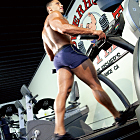 Q: What’s your take on probiotics for weight loss?
Q: What’s your take on probiotics for weight loss?
A: Emerging research shows that taking a probiotic to control insulin health and manage cortisol is a strategy for losing belly fat. There is a direct connection between belly fat gain and poor insulin health and cortisol production, and probiotics have been shown to have rather amazing affects on all three. Indeed, there’s ample evidence that taking a probiotic will directly lead to belly fat loss without a person’s going on a diet.
A 2010 study in the European Journal of Clinical Nutrition showed that taking a probiotic for 12 weeks significantly decreased belly fat in subjects by 4.6 percent; subjects lost an average of 5.8 square centimeters of visceral belly fat and 13 centimeters of total fat (visceral and subcutaneous). The probiotic group saw significantly greater drops in their bodyfat percentage, bodyweight, BMI and waist-to-hip circumference than did the control group.
For best results consider taking a probiotic daily. Many people think a probiotic is necessary only when they’re feeling sick, but considering the constant inundation of bad bacteria, heavy metals and oxidative stress we are exposed to, it’s become essential. It’s a no-brainer if you’re trying to lose fat.
Q: Will walking help me lose weight? I saw on “The Celebrity Apprentice” that Lou Ferrigno is a big believer in walking.
A: Lou had double knee and hip replacement surgery, so for a time walking was an ideal form of exercise for him. I can confidently say that walking had nothing to do with his becoming one of the best bodybuilders in the 1970s.
Walking is an ideal exercise for the obese because it is low impact and enables them to increase their caloric output without stressing the adrenals. One of the problems with many aerobics classes is that they involve high-impact activities that obese, untrained individuals simply cannot handle. So if you see mostly fit people in an aerobics class, it’s often because the obese participants were forced to quit due to injury.
As for walking on a treadmill, I don’t recommend it because it’s not a natural motion—the moving track decreases the work of the hip extensors; that is, the hamstrings and glutes. The resulting training effect could lead to structural imbalances, such as an increase in forward pelvic tilt due to tightness in the hip flexor muscles, such as the psoas, which could increase the risk of back pain. Ask any soft-tissue practitioner who has worked on clients who spent a lot of time on a treadmill, and he or she will tell you that such individuals often have extremely tight psoas muscles that can take several treatment sessions to resolve.
Editor’s note: Charles Poliquin is recognized as one of the world’s most suc-cessful strength coaches, having coached Olympic med-alists in 12 different sports, including the U.S. women’s track-and-field team for the 2000 Olympics. He’s spent years researching European journals (he’s fluent in English, French and German) and speaking with other coaches and scientists in his quest to optimize training methods. For more on his books, seminars and methods, visit www.CharlesPoliquin.com. Also, see his ad on page 131. IM




















You must be logged in to post a comment Login